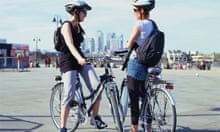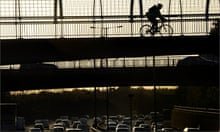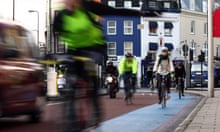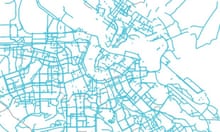Copenhagen now has so many cyclists that the city is installing electronic information panels along its bike lanes to help prevent two-wheeled traffic jams.
In what city hall has called a world first, an initial five screens will be fitted at strategic points on the Danish capital’s 390km (240-mile) network of protected bike lanes, the state broadcaster Danmarks Radio reported.
“There’s a need for improved accessibility for the growing number of cyclists who unfortunately in many places are now having to fight for space on the bike lane,” said Morten Kabell, head of the city’s technology and environment department.
“We’re hoping with these new information boards to give cyclists the opportunity to choose the least congested route through the city.”
Copenhagen’s residents cycled 1,400,000 km a day last year, with 41% of people – including 63% of MPs – cycling to and from work or school, and 32% of all city-centre journeys being made by bike.
Last year, the number of bikes entering the city centre exceeded cars for the first time: sensors recorded 265,700 bicycles daily against 252,600 cars – a major increase from the first survey in 1970 that recorded 100,000 bicycles and 340,000 cars.
At the forefront of efforts to make roads more cycle-friendly, Copenhagen has seen bike traffic rise by 68% over the past 20 years. But despite spending more than 1bn Danish krone on cycling infrastructure since 2005, jams are now increasing.
“Cyclists are already experiencing congestion on the city’s most used cycle paths,” city hall said in February, unveiling an eight-year, Dkr 1.1-1.8bn (£130m-£210m) cycle lane priority plan.
Forecasts show daily bike traffic across Copenhagen set to grow by 25% by 2025 and by 36% in the rush hour.
Several Copenhagen bike lanes are already reaching capacity at peak times, with one – across the Queen Louise bridge – reportedly the busiest in the world, carrying up to 40,000 cyclists a day.
“With the number of cyclists in Copenhagen now, we have a congestion problem,” Niels Agerholm, a traffic researcher at Aalborg university, told Danmarks Radio.
“If there is an easier way through, signs like these could get people to change direction.”
The new signs, costing Dkr4.2m, will carry information on roadworks, special events, distance to destinations, queues and slow-moving bike traffic, and suggest alternative routes using different bike lanes.
Other infrastructure changes to speed up city-centre journeys include widening existing lanes, improving signalling at intersections and building more bike-only bridges to add to the 17 already installed.
The city also recently introduced a “green” update to ibikecph, its route planning app. Besides offering cyclists a fast route, a cobblestone-avoiding alternative and another suited to cumbersome cargo bikes transporting small children, it now also suggests a quieter, more restful “green” route.
With a traffic density four times lower than that of the city’s regular bike paths, some 60km of Copenhagen’s integrated bike paths are now classified as “green routes”, with a further 57km planned, city hall said.
Typical users include older cyclists, families with children and people simply not in so much of a hurry. The app has been downloaded on to mobile phones more than 60,000 times and is consulted more than 20,000 times a month.









Comments (…)
Sign in or create your Guardian account to join the discussion